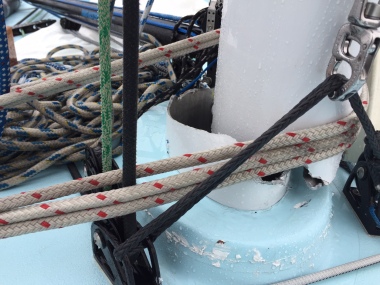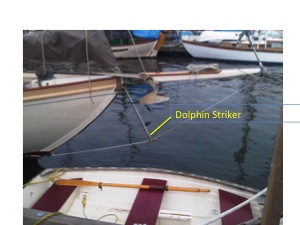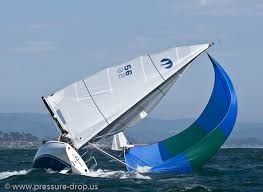Pac-cup. The start!
Wed July 13. 7:30 AM
Munching on a delicious “pnut beure et jelie,” complements of master chef, Scott Barber.
Mondays start: An amazing group of well wishers on the dock. Nervous energy everywhere. We bid them all adieu, and head out a little early, noting that the 13-knot wind is already strong enough to merit the #3 jib, rather than the big #1 genoa. After our sails are up, we notice that Redhead, another Cal-40 and one of our main competitors, put up her #1. We’ve previously used our well-cut # 3 to sail past Cal 40s down in LA carrying their #1 in 13 knots of breeze, so we are cautiously optimistic, especially given the forecast of a building 20-25 knot northwesterly. We know that the global objective is to be on the right end of the line to get to the middle of the channel, where the current is strongly going out the middle of the bay. However, the left side of the line is so very favored that the boats in our start (maybe 10 boats) are well dispersed along the line. Redhead gets a spectacular start on the port side of the line with a ton of speed. We get the second best start with less speed, but come on, let’s crank in the #3 and get Psyche in the groove, and we should steadily move ahead of the over-canvassed Redhead.
We don’t.
Redhead just keeps marching over the top of us as we all near the Golden Gate bridge (I forgot to look up underneath the bridge, so caught up was I in the race). Thats ok, think we. As the wind climbs into the mid-late teens, we should start to move on her.
The wind dies.
What the hell? The forecast called for a steadily increasing wind. But Redhead knew (and I now vaguely remember someone saying something about this) that just past the Gate, the wind often abates, until one has reached the synoptic wind, a few miles farther where the wind that is beyond control of coastal contours, and is free to blow.
So we flounder in the light stuff, and drag the # 1 out of the bilge and hank it on, and now we are finally holding our own, but Redhead is far ahead. We tack into Bonita Point hoping for the Northwesterly, and don’t get it. Out we go on starboard tack again. Heading for the shipping lanes.
Big oblivious humpback whales EVERYWHERE! Really cool views of gnarly backs and blowholes and black tiny dorsal fins.
A view of whitecaps on the horizon. We tack to port again, hoping to get into that wind a little earlier. Finally the wind fills. It strengthens gradually to 15-18 knots. Psyche is tipping too much, so we change back down to the #3 as we tack over to starboard and head toward Farallone Island.
Lots of chop and slop, and we have to keep things a little loose to keep our speed up. Seems like we might be gaining on Redhead, although she is pretty far out there in the mist.
We’ve finally sailed into the synoptic wind. Cooler, gusty. It grows into the 20s. Everyone sitting on the weather rail happy to be in a groove, determined to run down Redhead.
The wind strengthens more (as advertised), inching over 25. We put a reef in the mainsail (see previous blog), and Psyche starts to dance. The wind has shifted to the right ever-so-slightly, and we start to fly. 8 knots, 9 knots, even a 10 in there every now and then. We seem to be gaining on the two boats (Redhead and another) ahead of us.
We see cold, moldy, Southeast Farallone Island to windward, an apparition in the fading light. I spent 2 very memorable weeks doing intertidal research on that island, but that is another story.
Night time, now. The wind gusting, the white-caps breaking over the boat. Suddenly with a shout, Jimmy says oh no! The line that holds ALL our halyards, the lines we plan to use to pull up our sails all the way to Hawaii, breaks! Up go all the halyards, swinging in the breeze, just out of reach. If they get up too high the weight of the line on the other (mast side) of the blocks through which they run will take the outboard side of the blocks all the way up the mast. The only way to retrieve lost halyards is to drop the jib and use its halyard to send a man (that would have been an interesting lottery) up to the top to grab the halyards and pull them down. Not something we want to do in 25 knots and breaking seas.
Jimmy is tall, he snags a halyard. I am lucky and a bundle of halyards swings into my hands. We pull them down. Jimmy makes a new tie-down line. The whole operation would take maybe 2 min in calm weather. It takes about 15 minutes tonight. Waves just crashing all over us, water sluicing up the boots and into everything. Thoroughly soaked. Very cold. But the crisis is averted.
I go off watch and sleep in my favorite quarter berth. Funny how easy it is to sleep down there. But cold! I could have tripled my supply of long undies. But this will pass I keep saying. The water gets warm very quickly as one sails west and south from these cold upwelled seas.
After waking up, I notice a new rattle on the port side. In my usual optimistic “la-la-la” way, I think, oh its nothing. Jimmy comes up for the second part of my watch and says, I wonder what in the heck is making that noise? I say, quite predictably, I heard it too; its probably nothing. Jimmy works his way forward in the pitching darkness. The shrouds are really loose! What is going on here? He comes down and checks the backstay. Its fine. He runs his flash-light up mast, perhaps a spreader is bent or broken. Nope. Then he shines it on the base of the mast.
All hands on deck! We’re losing the mast!
Cal-40 masts have their bottom end on top of the keel. The mast rises from the keel through the deck, where it is supported by myriad wires, shrouds on the sides, stays fore and after. Somehow, our mast is torn at the deck. It is a mystery why the mast has not toppled. Several inches of the mast above the tear collapsed onto the cabin top next to the part below the tear. This could very well turn from bad to worse, hence Jimmys call.
So, we have a serious emergency on our hands. It takes FOREVER for the crew to get their foul weather gear and flotation devices and head-lamps together and on, but finally everyone is on deck in the pitching stormy darkness working to get the jib and mainsail down. I am steering, and head the boat down wind to lighten the load on mast. The sails are so wet and heavy, this is a monumental task.

Note in the photo above (taken from forward of the mast) that the upper part of the mast has torn itself free of the lower part of the mast, and is resting on the cabin-top’s platform to the right). We’ve lashed with line (white with red dashes) the the sheared off part, trying to prevent it from sliding off, thus toppling the mast. A second critical point is that the downward force of all the shrouds and stays and halyards in this wind is huge. Instead of this force being applied to the keel on the bottom of the boat, it all pushing against the cabin top. It is most remarkable that the cabin didn’t collapse under the weight. Steve had the cabin reinforced prior to the race, probably explaining this puzzle.
One of the most sickening things in my sailing experience is a sailboat at sea with no sails up. I previously described one of the circumstances, a hurricane in survival conditions. Much more mundanely, is on the old Siwash, after she has sailed up to Howland’s Cove on Catalina, smartly into the wind, drop the sails. Now there are no sails on the mast; the boat rolls sickeningly. I always get a little sea sick at that moment, when a sailboat is nearly at a standstill rolling in a sea-way back and forth, much more gut-wrenchingly than if even a small sail is up, steadying the roll.
Here is another bare-pole circumstance. A dismasting. Psyche is dismasted now. Her mast is standing, but it is just a ghost, never to hold a sail again. We are very, very, lucky that mast didn’t just topple over, creating a tangled mess of blunt weapons that can beat holes into hull and human heads, indiscriminately. That is the fire drill that was averted by Jimmy’s alert listening, and functional curiosity. Now the mast is wobbling in the 6 ft breaking seas, as we sail straight downwind under bare poles. Psyche is rolling horribly, so unnatural and scary. It is very hard to keep footing in this shit. After more than an hour of securing and stowing and trying to get the situation under control, we start the engine, and head toward Monterey. We call the coast-guard. “Pan-Pan ” is the call, kind of a Mellow May-Day. This is what you are supposed to say when you are in trouble, but not at risk to life or limb.
We set the motor to “slow” to reduce gasoline consumption, and started the rolly-poley bare-poles trip to Monterey.
So it is now nearly 9 AM a day later, and we are motoring into Monterey. Happy to be safe, but really sad we couldn’t continue in the race, for it most assuredly will be a record breaker, with a tropical depression climax. We will have to wait till another time.














